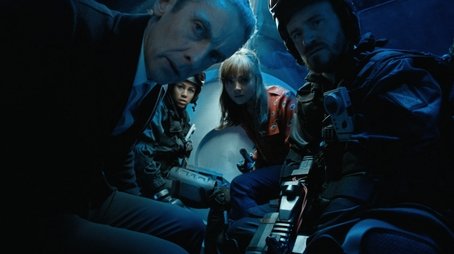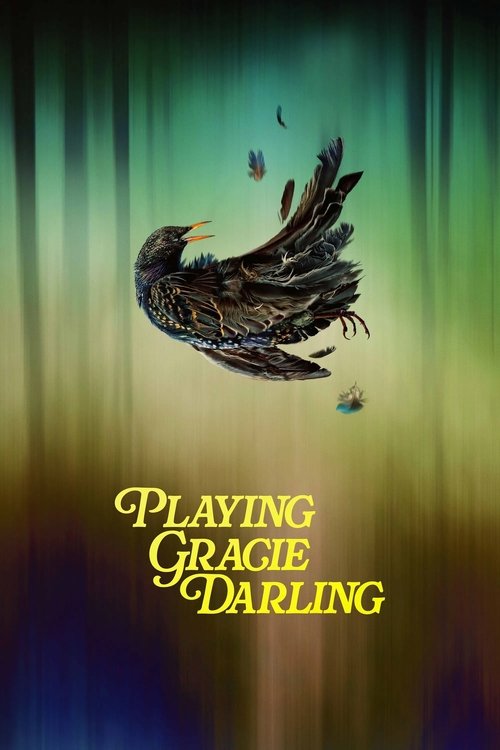
Ask Your Own Question
What is the plot?
The episode begins with the Doctor, portrayed by Peter Capaldi, and his companion, Clara Oswald, played by Jenna Coleman, arriving at a military base in the future. They are greeted by a group of soldiers who are preparing for a mission involving a Dalek. The Doctor is initially dismissive of the military's approach, expressing his disdain for their methods and their reliance on weapons. Clara, however, is intrigued and eager to understand the situation.
The Doctor learns that a Dalek has been captured and is being held in a containment unit. The soldiers, led by Colonel Morgan Blue, are attempting to extract information from it. The Doctor is skeptical about the Dalek's ability to change, but Clara insists that they should try to understand it. The Doctor reluctantly agrees to help, but he is wary of the Dalek's potential for violence.
As they approach the containment unit, the Doctor and Clara witness the Dalek's aggressive behavior. The creature is in a state of distress, claiming that it is "not a Dalek" and expressing a desire to be free. The Doctor is intrigued by this anomaly, as it suggests that the Dalek may have developed a sense of morality. Clara, however, is concerned about the implications of a "good" Dalek.
The situation escalates when the Dalek suddenly attacks, causing chaos in the base. The Doctor realizes that the Dalek's distress is linked to its internal conflict, and he decides to enter the Dalek's casing to understand its inner workings. Clara and the soldiers are hesitant but ultimately agree to assist him. The Doctor uses a device to shrink himself down and enters the Dalek, while Clara and the others monitor the situation from outside.
Inside the Dalek, the Doctor encounters a complex network of circuits and systems. He discovers that the Dalek's hatred for all non-Dalek beings is deeply ingrained, but there is a flicker of something different within it. The Doctor attempts to communicate with the Dalek, trying to understand its perspective. He learns that the Dalek has been damaged and is experiencing a crisis of identity.
Meanwhile, outside the Dalek, Clara and the soldiers are dealing with the fallout of the creature's attack. They are forced to confront their own fears and prejudices about the Daleks. Clara, in particular, grapples with her feelings about the Doctor's willingness to engage with a creature that has caused so much destruction.
As the Doctor continues to explore the Dalek's inner workings, he realizes that the creature's core is malfunctioning. He attempts to repair it, but the Dalek's programming fights back, leading to a tense standoff. The Doctor is determined to help the Dalek find its true self, but he is also aware of the risks involved.
The situation becomes dire when the Dalek begins to regain its full power and turns on the soldiers. The Doctor must act quickly to prevent a massacre. He devises a plan to use the Dalek's own programming against it, hoping to trigger a moment of clarity that will allow the creature to see beyond its hatred.
In a climactic moment, the Doctor confronts the Dalek, challenging it to recognize the good within itself. He uses a device to amplify the Dalek's internal conflict, forcing it to confront its own nature. The Dalek experiences a moment of clarity, expressing a desire to be free from its hatred. However, this moment is short-lived, as the Dalek ultimately succumbs to its programming and attacks the Doctor.
In the chaos, Clara and the soldiers manage to regain control of the situation. They work together to contain the Dalek, but the Doctor realizes that the creature cannot be saved. He makes the difficult decision to destroy the Dalek, knowing that it is the only way to prevent further violence.
The episode concludes with the Doctor and Clara reflecting on the events that transpired. Clara is troubled by the Doctor's actions and the moral implications of his choices. The Doctor, on the other hand, is left grappling with the weight of his decisions and the nature of good and evil. They leave the military base, both changed by their experiences and uncertain about the future.
What is the ending?
At the end of "Into the Dalek," the Doctor and his team manage to escape from the Dalek's interior after successfully disabling it. They return to the TARDIS, and the Doctor reflects on the nature of the Daleks, realizing that they are inherently evil. The episode concludes with the Doctor's determination to confront the Daleks again, while Clara expresses her concern about the Doctor's darker side.
As the episode nears its conclusion, the tension within the Dalek intensifies. The Doctor, Clara, and the soldiers, including Journey Blue and the injured Lieutenant, find themselves in a precarious situation. They have successfully navigated the Dalek's inner workings, but the creature is still very much alive and dangerous. The Doctor, with his characteristic bravado, takes charge, urging the team to focus on their escape.
In a pivotal moment, the Doctor realizes that the Dalek has been corrupted by the experiences it has had with the human race. He understands that the Dalek's hatred is not just a product of its design but has been influenced by the memories it has absorbed. This revelation strikes a chord with the Doctor, who grapples with the implications of what it means to be a creature of hate and violence.
As they make their way to the exit, the Doctor devises a plan to disable the Dalek. He instructs Clara and the others to create a distraction while he works on the Dalek's systems. The tension is palpable as they race against time, knowing that the Dalek could awaken at any moment. Clara, showing her bravery, takes on a significant role in the plan, demonstrating her growth as a companion.
Once they reach the control panel, the Doctor manages to disable the Dalek's weaponry, but not before it has a final confrontation with him. The Dalek, in a moment of clarity, questions the Doctor's own morality, asking if he is truly a good man. This moment is crucial, as it forces the Doctor to confront his own identity and the darker aspects of his character.
With the Dalek incapacitated, the team makes a hasty retreat back to the TARDIS. Journey Blue, who has shown great courage throughout the ordeal, is left with a sense of loss as she realizes the futility of their fight against the Daleks. The Lieutenant, who has been injured, is taken back to safety, but the experience has left him shaken.
As they arrive back at the TARDIS, Clara expresses her concern to the Doctor. She worries about the darkness she has seen within him, questioning whether he is truly the hero he claims to be. The Doctor, reflecting on the events, acknowledges the complexity of his nature. He is not just a savior but also a being capable of great destruction.
The episode concludes with the Doctor's resolve to face the Daleks again, hinting at the ongoing conflict between good and evil that defines his character. Clara, still grappling with her feelings about the Doctor, stands by him, but the seeds of doubt have been planted. The final scene leaves viewers with a sense of unease, as the Doctor's journey continues, fraught with moral ambiguity and the weight of his choices.
Is there a post-credit scene?
In "Into the Dalek," there is no post-credit scene. The episode concludes without any additional scenes or content after the credits roll. The focus remains on the main narrative and character development throughout the episode, particularly highlighting the Doctor's complex relationship with the Daleks and his own moral dilemmas. The story wraps up with the Doctor, Clara, and the surviving members of the team reflecting on their harrowing experience inside the Dalek, emphasizing themes of fear, compassion, and the nature of good and evil.
How does the Doctor's relationship with Clara evolve in this episode?
In this episode, the Doctor and Clara's relationship is tested as they face the Dalek threat together. Clara's concern for the Doctor's darker tendencies surfaces, especially when she witnesses his willingness to use the Dalek's desire for goodness to their advantage, leading to tension between them.
What is the significance of the Dalek that the Doctor encounters?
The Dalek that the Doctor encounters is unique because it expresses a desire to be good, which is contrary to the Daleks' nature of hatred and extermination. This internal conflict raises questions about the nature of good and evil, and whether a creature can change its fundamental programming.
What role does the character Journey Blue play in the story?
Journey Blue is a soldier who accompanies the Doctor and Clara into the Dalek's interior. She represents the human element in the face of Dalek terror, showcasing bravery and determination. Her character also highlights the moral complexities of war and the impact of the Daleks on humanity.
What is the Doctor's reaction to the Dalek's claim of wanting to be good?
The Doctor is initially skeptical and intrigued by the Dalek's claim of wanting to be good. He grapples with the implications of this statement, reflecting on his own identity and the nature of his enemies. His reaction is a mix of curiosity and caution, as he considers the potential for change in a creature designed for destruction.
How does the episode explore the theme of identity through the Dalek?
The episode explores identity through the Dalek's struggle with its programming and the concept of being 'good.' The Doctor's interactions with the Dalek reveal the complexities of identity, as the Dalek's desire to be more than a killer challenges the Doctor's understanding of what it means to be a monster or a hero.
Is this family friendly?
"Into the Dalek" from Doctor Who's Series 8 contains several elements that may be considered objectionable or upsetting for children or sensitive viewers. Here are some aspects to be aware of:
-
Violence and Conflict: The episode features scenes of conflict between the Daleks and humans, including moments of shooting and destruction that may be intense for younger viewers.
-
Dalek Threat: The Daleks are portrayed as menacing and ruthless creatures, which can be frightening. Their aggressive nature and the concept of extermination may be unsettling.
-
Emotional Turmoil: Characters experience fear, despair, and moral dilemmas, particularly regarding the nature of good and evil, which may provoke anxiety or confusion in younger audiences.
-
Body Horror: There are scenes that involve the concept of being shrunk down and entering a Dalek's body, which may be visually disturbing or evoke feelings of claustrophobia.
-
Death and Sacrifice: The episode touches on themes of sacrifice and the consequences of war, which may be heavy topics for children to process.
These elements contribute to the overall tone of the episode, which balances adventure with darker themes, making it potentially challenging for younger or more sensitive viewers.











